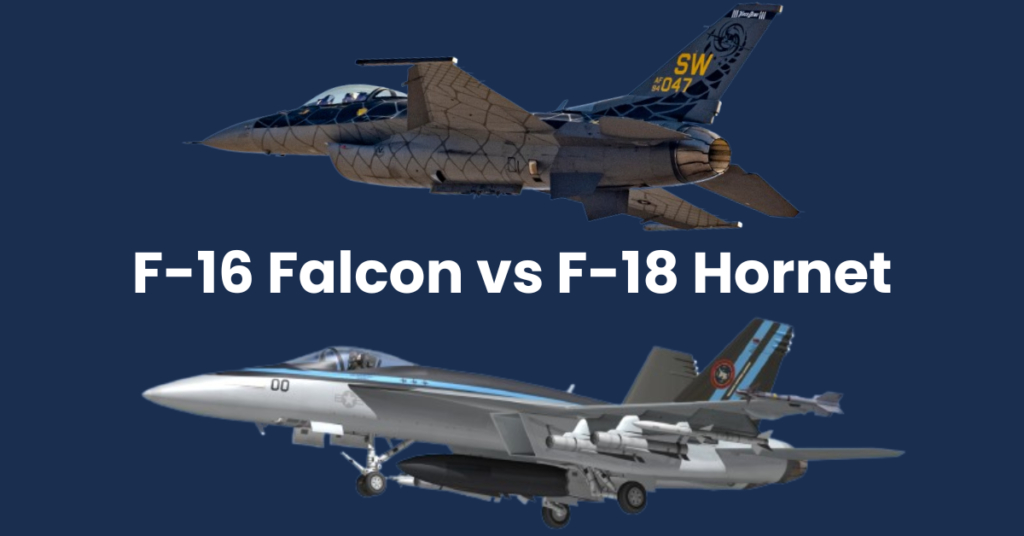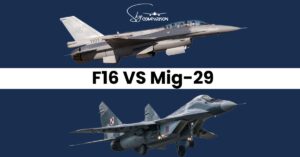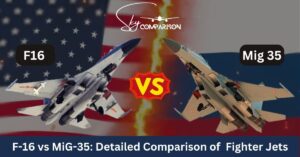F16 vs F18 | Comparing the F-16 & F-18 Fighting Power, Speed
The F-16 Fighting Falcon vs F-18 Hornet are both stalwarts in the arena of fighter jets, but they differ significantly in design, functionality, and operational use.
F16 vs F18

F16 vs F18, the F-16 Fighting Falcon and F-18 Hornet are two of the most prominent fighter jets in the U.S. military’s arsenal, each boasting unique features and capabilities. The F-16, known for its agility, is a single-engine jet that excels in both air-to-air and air-to-ground missions, making it a versatile asset in combat. Its design prioritizes speed and maneuverability, with a top speed of Mach 2. On the other hand, the F-18 Hornet is a twin-engine aircraft, providing extra reliability and power, and is capable of operating from aircraft carriers.
Check out our comparison of the F16 vs MIG-35 to see how they differ.
This makes the F-18 highly valuable for naval operations, offering a blend of attack and fighter capabilities to handle both aerial and surface threats. While both aircraft can carry a wide range of weapons and have advanced avionics, the choice between them often depends on the specific mission requirements and operational context, with the F-16 favoring speed and cost-effectiveness, and the F-18 offering robust multi-role functionality.
| Feature | F-16 Fighting Falcon | F-18 Hornet |
|---|---|---|
| Role | Multirole Fighter | Multirole Fighter |
| Manufacturer | Lockheed Martin | McDonnell Douglas / Boeing |
| First Flight | January 20, 1974 | November 18, 1978 |
| Engine Type | Single-engine | Twin-engine |
| Top Speed | Mach 2 (Approx. 1,500 mph) | Mach 1.8 (Approx. 1,190 mph) |
| Combat Range | Approx. 1,240 miles | Approx. 1,250 miles |
| Armament | M61 Vulcan cannon, air-to-air missiles, air-to-ground missiles, and bombs | M61 Vulcan cannon, air-to-air missiles, air-to-ground missiles, and bombs |
| Avionics | Advanced radar and targeting systems | Advanced radar, targeting systems, and electronic warfare capabilities |
| Crew | Single (with two-seat variants for training) | Single or Two (F/A-18D and later variants) |
| Wing Configuration | Delta wing with leading-edge flaps | Twin tail, mid-wing configuration |
This table covers a range of features that highlight the differences and similarities between these two advanced fighter aircraft, including their roles, manufacturers, specifications, and capabilities.
F-16 Fighting Falcon vs F-18 Hornet specifications
Here’s a comparison table focusing on the specifications of the F-16 Fighting Falcon vs F-18 Hornet:
| Specification | F-16 Fighting Falcon | F-18 Hornet |
|---|---|---|
| Length | 49 ft 5 in (15.06 m) | 56 ft (17.07 m) |
| Wingspan | 32 ft 8 in (9.96 m) | 40 ft 4 in (12.3 m) |
| Height | 16 ft (4.88 m) | 15 ft 4 in (4.67 m) |
| Wing Area | 300 sq ft (27.87 sq m) | 400 sq ft (37 sq m) |
| Empty Weight | 18,900 lb (8,570 kg) | 23,000 lb (10,400 kg) |
| Max Takeoff Weight | 42,300 lb (19,200 kg) | 51,900 lb (23,541 kg) |
| Powerplant | 1 × General Electric F110-GE-100 turbofan | 2 × General Electric F404-GE-402 turbofans |
| Maximum Speed | Mach 2.0 (1,500 mph, 2,414 km/h) at altitude | Mach 1.8 (1,190 mph, 1,915 km/h) at altitude |
| Range | 2,620 mi (4,220 km) | 1,250 mi (2,000 km), extendable with refueling |
| Service Ceiling | 50,000 ft (15,240 m) | 50,000 ft (15,240 m) |
| Rate of Climb | 50,000 ft/min (254 m/s) | 30,000 ft/min (150 m/s) |
| Armament | M61 Vulcan cannon, missiles, and bombs | M61 Vulcan cannon, missiles, and bombs |
| Crew | 1 (2 in F-16D variant) | 1 (2 in F/A-18D variant) |
Lockheed Martin F-16 Fighting Falcon
The Lockheed Martin F-16 Fighting Falcon is a single-engine, multirole fighter aircraft originally developed by General Dynamics for the United States Air Force. Recognized for its distinctive delta wing design and bubble canopy, the F-16 was designed to be a nimble aircraft capable of achieving high speeds—up to Mach 2. With its introduction in the late 1970s, it revolutionized aerial combat with its advanced avionics, superior maneuverability, and powerful armament capabilities. The F-16 is extremely versatile, used for air-to-air combat as well as air-to-surface attacks. Over the years, it has been adopted by numerous countries worldwide, serving as a cornerstone in the defense forces of many nations. Its longevity and effectiveness continue to make it a vital component of air forces around the globe.
McDonnell Douglas F-18 Hornet
The McDonnell Douglas F-18 Hornet is a robust, twin-engine, multirole fighter jet designed to operate from aircraft carriers and land bases alike. Introduced in the 1980s by McDonnell Douglas, now part of Boeing, the F-18 was engineered to fulfill both air-to-air combat and ground-attack duties effectively. Its versatility is highlighted by its use in the U.S. Navy and Marine Corps, where it has played critical roles in both defensive and offensive operations. The Hornet is particularly noted for its ability to carry a hefty payload of weapons and its advanced avionics that support a variety of missions. With its impressive agility and speed, reaching up to Mach 1.8, the F-18 has proven to be a reliable asset in numerous military engagements around the world. The aircraft’s adaptability and enduring performance make it a mainstay in modern aerial combat strategies.
F16 vs F18 Top 10 Differences
The F-16 Fighting Falcon and the F-18 Hornet are two of the most sophisticated aircrafts in the U.S. military, each designed with unique capabilities and specialized roles. Here are the top 10 differences between these two powerhouse jets:
- Speed and Performance: The F-16 can reach a maximum speed just over Mach 1.7, which is slightly slower than the F-18’s Mach 1.8. However, the F-16 often has a higher operational speed due to its lighter single-engine design compared to the F-18’s twin-engine setup.
- Manufacturers: The F-16 is a product of General Dynamics and Lockheed Martin, while the F-18 was developed by McDonnell Douglas, which later merged with Boeing.
- Engines: The F-16 is equipped with a single Pratt & Whitney or General Electric turbofan engine, providing up to 29,000lbs of thrust. In contrast, the F-18 uses two General Electric F404 engines, each offering up to 17,700 lbs of thrust, for a combined higher output.
- Branches of Service: The F-16 is extensively used across the Air Force, Navy, and National Guard, whereas the F-18 is primarily operated by the Navy and Marine Corps, reflecting its design for carrier-based operations.
- Combat Roles: Both aircraft are versatile in air-to-air and air-to-ground missions. The F-18, with its carrier capabilities and longer combat radius, excels in naval operations, while the F-16 is valued for its longer range and agility in air dominance roles.
- Maneuverability: The F-16 is renowned for its ability to perform 9G maneuvers. The F-18 is also capable of 9G maneuvers but is often limited to 7.5Gs to preserve airframe integrity. The F-18’s design includes enlarged leading edge extensions for improved lift and agility.
- Design: The F-16 is more compact with a smaller wingspan and lighter weight, enhancing its speed and maneuverability. The F-18 is larger, which supports its dual role and twin-engine reliability but adds to its weight.
- Costs: An F-16 is less expensive both in initial cost, approximately $35 million per unit, and operational costs. The F-18 costs about $67 million per unit and has higher per-hour operating costs due to its dual engines.
- Dogfight Capabilities: The F-16 has a higher operational range and can handle more intense G-forces, making it superior in certain types of air combat. The F-18, with its ability to operate from carriers, offers tactical flexibility not available to the F-16.
- Global Users: The F-16 is used by numerous countries around the world due to its affordability and versatility. The F-18, while less widely used, is favored for its robust capabilities and carrier operations, serving countries with advanced naval forces.
Each jet has been meticulously designed to meet specific needs within the U.S. military and its allies, making them invaluable assets in modern aerial and naval warfare.
F16 vs F18 Engines
When comparing the engines of the F-16 Fighting Falcon vs F-18 Hornet, key differences become apparent, impacting their performance and reliability. The F-16 is equipped with a single engine, typically either a Pratt & Whitney F100 or a General Electric F110. This setup provides a powerful thrust that enhances the jet’s speed and agility, making it incredibly efficient in air-to-air combat. On the other hand, the F-18 utilizes twin General Electric F404 engines, which offer increased reliability and safety — crucial for aircraft that operate from the challenging environments of aircraft carriers. While the F-18’s dual engines make it heavier and slightly slower, they also allow the aircraft to continue flying even if one engine fails, a significant advantage in combat situations where engine failure can be catastrophic.
F16 vs F18 Size
The F-16 Fighting Falcon and the F-18 Hornet differ notably in size, which impacts their operation and capabilities. The F-16 is smaller and more streamlined, with a length of about 49 feet and a wingspan of 32 feet. This compact design enhances its agility and speed, making it ideal for quick maneuvers and high-speed combat. On the other hand, the F-18 is larger, measuring approximately 56 feet in length with a 40-foot wingspan. The bigger size of the F-18 allows it to carry more fuel and weaponry, which is advantageous for longer missions and heavier attacks. Additionally, the F-18’s larger size is crucial for its role in aircraft carrier operations, providing stability and durability during take-offs and landings on carriers.
F16 vs F18 Speed & Fighting skills
The main differences in fighting skills between the F-16 Fighting Falcon and the F-18 Hornet stem from their design and operational capabilities. The F-16 is renowned for its agility and acceleration, features that make it exceptionally effective in air-to-air combat. Its design allows for tight turning and precise targeting, which are crucial in dogfight scenarios. Conversely, the F-18 Hornet is designed to excel in both air-to-air and air-to-ground combat, benefiting from its robust dual-engine configuration that enhances its survivability and performance, especially in high-risk environments like over water or hostile territory. Additionally, the F-18’s ability to operate from aircraft carriers provides it with unique operational flexibility, enabling it to engage in combat more quickly from various locations. Both aircraft are equipped with advanced weapon systems and avionics, but their tactical applications in combat can vary significantly due to these inherent differences in design and functionality.
F-16 vs F-18 Dogfight

F-16 vs F-18 dogfight, two of the most iconic fighter jets in modern aviation, each aircraft brings unique capabilities to the fray. The F-18, known for its versatility, is equipped with excellent agility and carrier-based operations, making it highly adaptable in various combat scenarios. On the other hand, the F-16 is celebrated for its incredible speed and precision, boasting advanced aerodynamics that allow for tight maneuvers and quick strikes. When these two jets engage in aerial combat, the outcome often depends on the pilots’ skill and tactical decisions, as both jets are designed to excel in close-range combat. Their sophisticated weaponry and systems make such encounters highly strategic, where every move and countermove can be critical.
Conclusion
In the showdown between the F-16 Fighting Falcon and the F-18 Hornet, it’s clear that each jet has its own set of strengths tailored to meet specific operational needs. The F-16 stands out for its agility and cost-effectiveness, making it a favorite for air forces that need a versatile, high-performance fighter. On the other hand, the F-18 excels with its robust dual-engine reliability and carrier capability, proving indispensable for naval operations. Both fighters continue to evolve and serve as pivotal assets in military strategies worldwide, demonstrating the enduring importance of their advanced capabilities in maintaining air superiority.
FaQs
Which aircraft is faster in the F16 vs F18 comparison?
The F-16 is slightly faster, reaching speeds just over Mach 1.7, while the F-18 tops out at Mach 1.8.
In the F16 vs F18 matchup, can both jets operate from an aircraft carrier?
No, only the F-18 is designed for carrier operations due to its robust landing gear and airframe, suitable for the harsh conditions of aircraft carrier landings.
What are the primary roles of each jet in the F16 vs F18 debate?
Both jets serve multi-role functions; however, the F-16 is primarily used by the Air Force for air-to-air combat and ground attacks, whereas the F-18 is utilized by the Navy for its versatility in both air-to-air combat and carrier-based operations.
What is the cost difference between the two jets in the F16 vs F18 analysis?
The F-16 is generally more cost-effective both in terms of initial cost and operational expenses compared to the more complex, twin-engine F-18.




